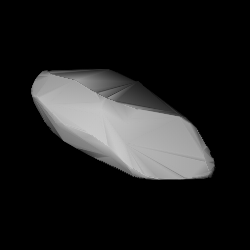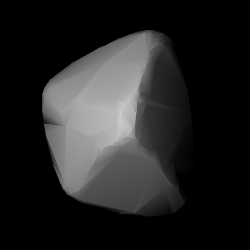Related Research Articles
2072 Kosmodemyanskaya, provisional designation 1973 QE2, is a stony asteroid from the inner regions of the asteroid belt, approximately 6 kilometers in diameter.
460 Scania is a background asteroid and a slow rotator from the central regions of the asteroid belt. It was discovered by German astronomer Max Wolf at the Heidelberg-Königstuhl State Observatory on 22 October 1900. The uncommon K-type asteroid has an exceptionally long rotation period of 164.1 hours and measures approximately 21 kilometers in diameter. It was named after the Swedish region of Scania, where a meeting was held by the Astronomische Gesellschaft in 1904.

1118 Hanskya is a large background asteroid, approximately 77 kilometers in diameter, located in the outer regions of the asteroid belt. Discovered by Sergey Belyavsky and Nikolaj Ivanov in 1927, it was named after Russian astronomer Aleksey Hansky. The presumed dark C-type asteroid has a rotation period of 15.6 hours.

1147 Stavropolis is a stony background asteroid from the inner regions of the asteroid belt. It was discovered on 11 June 1929, by Georgian–Russian astronomer Grigory Neujmin at the Simeiz Observatory on the Crimean peninsula. The S-type asteroid has a rotation period of 5.7 hours and measures approximately 14 kilometers in diameter. It was named after the Russian city of Stavropol.

1957 Angara is a stony Eos asteroid from the outer regions of the asteroid belt, approximately 18 kilometers in diameter. It was discovered on 1 April 1970, by Soviet astronomer Lyudmila Chernykh at the Crimean Astrophysical Observatory in Nauchnyj, and named after the Siberian Angara River.
1956 Artek, provisional designation 1969 TX1, is a dark Themistian asteroid from the outer regions of the asteroid belt, approximately 19 kilometers in diameter. It was discovered on 8 October 1969, by Soviet–Russian astronomer Lyudmila Chernykh at the Crimean Astrophysical Observatory in Nauchnyj. It was named after Artek, a Soviet Young Pioneer camp.
2892 Filipenko, provisional designation 1983 AX2, is a carbonaceous asteroid from the outer region of the asteroid belt, approximately 60 kilometers in diameter.
2126 Gerasimovich, provisional designation 1970 QZ, is a stony background asteroid from the inner regions of the asteroid belt, approximately 8 kilometers in diameter. It was discovered on 30 August 1970, by Soviet astronomer Tamara Smirnova at the Crimean Astrophysical Observatory in Nauchnyj, on the Crimean peninsula. The asteroid was named after Russian astronomer Boris Gerasimovich.
1479 Inkeri, provisional designation 1938 DE, is an asteroid from the central regions of the asteroid belt. It is an exceptionally slow rotator, suspected tumbler and measures approximately 19 kilometers in diameter. It was discovered on 16 February 1938, by Finnish astronomer Yrjö Väisälä at the Iso-Heikkilä Observatory in Turku, Finland. "Inkeri" is the name of two of the discoverer's younger relatives as well as the local name of the former Finnish province of Ingria.
2140 Kemerovo, provisional designation 1970 PE, is a dark asteroid from the outer region of the asteroid belt, approximately 30 kilometers in diameter.
1929 Kollaa, provisional designation 1939 BS, is a stony Vestian asteroid from the inner regions of the asteroid belt, approximately 7 kilometers in diameter. It was discovered by Finnish astronomer Yrjö Väisälä at Turku Observatory in Southwest Finland, on 20 January 1939. The asteroid was named after the Kollaa River in what is now Russia.
2008 Konstitutsiya, provisionally designated 1973 SV4, is a carbonaceous asteroid from the outer region of the asteroid belt, approximately 50 kilometers in diameter. It was discovered on 27 September 1973, by Soviet astronomer Lyudmila Chernykh at the Crimean Astrophysical Observatory in Nauchnyj, on the Crimean peninsula. The asteroid was named for the 1977 Soviet Constitution.

2094 Magnitka (prov. designation: 1971 TC2) is a Flora asteroid from the inner regions of the asteroid belt, approximately 12 kilometers (7.5 miles) in diameter. It was discovered on 12 October 1971, at and by the Crimean Astrophysical Observatory in Nauchnyj, on the Crimean peninsula. The discovery has not been attributed to an observing astronomer. It was later named for the city of Magnitogorsk.
4022 Nonna, provisional designation 1981 TL4, is a Vestian asteroid from the inner regions of the asteroid belt, approximately 4 kilometers (2.5 miles) kilometers in diameter. It was discovered on 8 October 1981, by Soviet–Russian astronomer Lyudmila Chernykh at the Crimean Astrophysical Observatory. The asteroid was named after Soviet actress Nonna Mordyukova. The nearly fast rotator has an exceptionally low lightcurve-amplitude indicating a nearly spherical shape.

1889 Pakhmutova, provisional designation 1968 BE, is a carbonaceous asteroid from the outer region of the asteroid belt, approximately 35 kilometers in diameter.
3345 Tarkovskij, provisional designation 1982 YC1, is a carbonaceous background asteroid from the inner regions of the asteroid belt, approximately 22 kilometers (14 miles) in diameter. It was discovered on 23 December 1982, by Russian astronomer Lyudmila Karachkina at the Crimean Astrophysical Observatory in Nauchnyj, on the Crimean peninsula, and named after filmmaker Andrei Tarkovsky. The C-type asteroid is a slow rotator with a rotation period of 187 hours.
1989 Tatry, provisional designation 1955 FG, is a carbonaceous Vestian asteroid and tumbling slow rotator from the inner regions of the asteroid belt, approximately 16 kilometers in diameter.

2120 Tyumenia is a dark background asteroid, approximately 45 kilometers in diameter, located in the outer regions of the asteroid belt. It was discovered on 9 September 1967, by Soviet astronomer Tamara Smirnova at the Crimean Astrophysical Observatory in Nauchnyj, on the Crimean peninsula. The asteroid was named for the now Russian district of Tyumen Oblast in Western Siberia.
2862 Vavilov, provisional designation 1977 JP, is a stony background asteroid and exceptionally slow rotator from the inner regions of the asteroid belt, approximately 7 kilometers in diameter. It was discovered on 15 May 1977, by Soviet astronomer Nikolai Chernykh at the Crimean Astrophysical Observatory in Nauchnij, on the Crimean peninsula. The asteroid was named after Russian plant geneticist Nikolai Vavilov and his physicist brother Sergey Ivanovich Vavilov.
2011 Veteraniya, provisional designation 1970 QB1, is a stony Vestian asteroid from the inner regions of the asteroid belt, approximately 6 kilometers in diameter. It was discovered on 30 August 1970, by Russian astronomer Tamara Smirnova at the Crimean Astrophysical Observatory, Nauchnyj, on the Crimean peninsula, and named for the Soviet veterans of the Second World War.
References
- 1 2 3 4 "JPL Small-Body Database Browser: 4524 Barklajdetolli (1981 RV4)" (2016-11-23 last obs.). Jet Propulsion Laboratory . Retrieved 20 June 2017.
- 1 2 3 Schmadel, Lutz D. (2007). "(4524) Barklajdetolli". Dictionary of Minor Planet Names – (4524) Barklajdetolli. Springer Berlin Heidelberg. p. 389. doi:10.1007/978-3-540-29925-7_4463. ISBN 978-3-540-00238-3.
- 1 2 "Asteroid 4524 Barklajdetolli". Small Bodies Data Ferret. Retrieved 23 July 2018.
- 1 2 "Asteroid (4524) Barklajdetolli – Proper elements". AstDyS-2, Asteroids – Dynamic Site. Archived from the original on 2 July 2020. Retrieved 23 July 2018.
- 1 2 3 4 5 6 7 8 "LCDB Data for (4524) Barklajdetolli". Asteroid Lightcurve Database (LCDB). Retrieved 30 June 2016.
- 1 2 3 4 5 Masiero, Joseph R.; Mainzer, A. K.; Grav, T.; Bauer, J. M.; Cutri, R. M.; Nugent, C.; et al. (November 2012). "Preliminary Analysis of WISE/NEOWISE 3-Band Cryogenic and Post-cryogenic Observations of Main Belt Asteroids". The Astrophysical Journal Letters. 759 (1): 5. arXiv: 1209.5794 . Bibcode:2012ApJ...759L...8M. doi:10.1088/2041-8205/759/1/L8 . Retrieved 30 June 2016.
- 1 2 3 4 5 Usui, Fumihiko; Kuroda, Daisuke; Müller, Thomas G.; Hasegawa, Sunao; Ishiguro, Masateru; Ootsubo, Takafumi; et al. (October 2011). "Asteroid Catalog Using Akari: AKARI/IRC Mid-Infrared Asteroid Survey". Publications of the Astronomical Society of Japan. 63 (5): 1117–1138. Bibcode:2011PASJ...63.1117U. doi:10.1093/pasj/63.5.1117. (online, AcuA catalog p. 153)
- 1 2 3 Pray, Donald P.; Durkee, Russell I. (January 2010). "The Extremely Long Period of 4524 Barklajdetolli". The Minor Planet Bulletin. 37 (1): 35. Bibcode:2010MPBu...37...35P. ISSN 1052-8091 . Retrieved 30 June 2016.
- ↑ Veres, Peter; Jedicke, Robert; Fitzsimmons, Alan; Denneau, Larry; Granvik, Mikael; Bolin, Bryce; et al. (November 2015). "Absolute magnitudes and slope parameters for 250,000 asteroids observed by Pan-STARRS PS1 - Preliminary results". Icarus. 261: 34–47. arXiv: 1506.00762 . Bibcode:2015Icar..261...34V. doi:10.1016/j.icarus.2015.08.007 . Retrieved 30 June 2016.
- 1 2 "4524 Barklajdetolli (1981 RV4)". Minor Planet Center. Retrieved 30 June 2016.
- ↑ "MPC/MPO/MPS Archive". Minor Planet Center. Retrieved 30 June 2016.